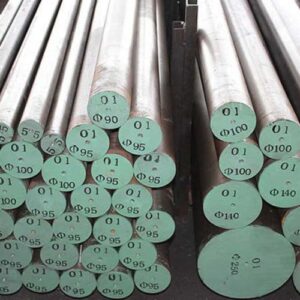Customized Tools: Tailoring Performance with Specific Tool Steels
 Off-the-shelf tool steels provide a good starting point. But for optimal performance, custom-tailored grades reign supreme. By tweaking compositions and treatments, engineers can create tooling steels honed specifically for each unique application.
Off-the-shelf tool steels provide a good starting point. But for optimal performance, custom-tailored grades reign supreme. By tweaking compositions and treatments, engineers can create tooling steels honed specifically for each unique application.
In this guide, we’ll explore how custom tool steels push performance boundaries compared to standard catalog grades. Discover how slight differences in alloys and processing produce specialized materials exceeding what’s possible with generic options. When tool steel is made for you rather than everyone, it unlocks game-changing capabilities to excel in your niche.
Limitations of Standard Tool Steels
Standardized tool steel grades offer convenient solutions that work reasonably well for many uses. However, general-purpose compositions involve trade-offs:
- Trying to balance wear resistance, toughness, and stability leads to compromises rather than optimization.
- Economical large-scale production limits precise alloy control and melting techniques.
- Common heat treatments aim for broad usability rather than maximum properties.
- Meeting minimum specifications satisfies most buyers but leaves potential untapped.
While standardized steels provide a great starting point, custom grades break compromises and push optimal performance.
The Promise of Tailored Tool Steels
Custom tool steels precisely match compositions and treatments to application demands. This enables:
- Maximizing wear resistance, heat tolerance, or toughness rather than balance.
- Including or excluding specific elements based on their impact.
- Tight chemistry control through specialized melting and remelting.
- Optimized heat treating for the particular tool geometry and function.
- Uncompromising quality standards, testing, and certifications.
- Opportunities for unique enhancements like embedded sensors or coatings.
- Improving function or extending service life of high value tooling.
- Achieving the ideal combination of steel attributes not possible in catalog grades.
The specialization unlocks the full potential of tool steels.
Collaborating with Experts
Creating custom tool steels requires collaborating with specialized producers:
Tool Steel Mills
Reputable tool steel mills offer custom alloy creation and ingot casting with stringent chemistry and quality controls. This provides the foundation.
Tooling Producers
Tooling manufacturers contribute understanding of design objectives and fabrication requirements to inform steel modifications.
Heat Treat Specialists
Thermal processing experts tailor heating, quenching, and tempering to manifest optimum properties in the finished tools.
Third-party Experts
Independent consultants, academics, and national labs provide unbiased expertise to perfect custom alloys and treatments.
The combined knowledge delivers tool steels exceeding compromises of mass produced grades.
Modifying Compositions
Adjusting alloy levels targets desired attributes:
Boosting Hardening Elements
Additional chromium, molybdenum, vanadium, and tungsten increase hardness potential through carbide formation and grain refinement.
Adding Toughness
Bumping cobalt, nickel, or manganese improves ductility and fracture resistance for high-impact applications.
Enhancing Wear Resistance
Higher carbon and cobalt concentrations imparts abrasion resistance with hardness.
Reducing Residual Elements
Lowering sulfur, phosphorus, oxygen, and nitrogen minimizes unwanted contaminants.
Tailoring Corrosion Resistance
Increasing chromium and nickel improves oxidation and chemical resistance.
Subtle chemistry shifts make a remarkable impact when optimized for the operating conditions.
Melting Enhancements
Superior melting capabilities deliver ultraclean tool steel:
Vacuum Induction Melting
VIM melts and refines alloys in a vacuum, virtually eliminating contaminants and gases.
Vacuum Arc Remelting
VAR re-melts VIM ingots into higher purity slabs with improved homogeneity.
Electroslag Remelting
ESR melts inch-diameter bars from VIM ingots removing remaining deoxidization products.
Powder Metallurgy
P/M uses metal powders and hot isostatic pressing to create fine-grained, consistent microstructures.
Rigorous melting promotes the fed properties needed for extreme tool performance.
Optimizing Heat Treatment
Carefully tailored thermal processing unlocks maximum potential:
Solution Annealing
Heating specifically to dissolve carbides primed for re-precipitation.
Quench Medium and Speed
Choosing the quenchant and agitation suited to the particular alloy and section size.
Interrupted Quenching
Programmed steps allowing gradual cooling to avoid distortion in thick tooling.
Multi-Stage Tempering
A series of tempers fine-tune hardness, relieve stresses, and stabilize dimensions.
Sub-Zero Treatment
Cryogenic processing encourages complete transformation and reduces residual austenite.
The optimized recipe manifests properties unavailable using stock heat treatments.
Enhanced Machining
Machining methods can be adjusted for superior fabrication:
Optimized Cutting Approaches
Tools, speeds, and strategies tailored to the specific workpiece geometry and alloy.
Precision Grinding
Tight process controls create complex shapes with minimal distortion.
Wire EDM
Carefully managed wire EDM achieves intricate contours and sharp edges.
Surface Treatments
Applying specialized coatings or surface hardening.
Automated Machining
Precision CNC techniques for the highest quality and repeatability.
Adjustments remove limitations of generic machining protocols applied to all alloys.
Rigorous Testing
Validation testing proves out custom grades:
Composition Verification
Chemical analysis confirms material chemistry and uniformity.
Mechanical Testing
Tensile, impact, fracture, and fatigue tests characterize properties.
Microstructural Analysis
Imaging validates fine, uniform carbide distributions and grain structure.
Trial Tool Fabrication
Inspection of machined test tools validates fabrication processes.
Accelerated Testing
Punishing conditions like overloads, corrosion, and temperature extremes verify performance.
Field Testing
Controlled deployment in production confirms results before high volume use.
Careful testing at each step instills confidence in journal grades performing as designed.
When Custom Steels Excel
Some prime applications for tailoring tool steel grades include:
Extreme Environments
Ultra-high temperatures, caustic chemicals, and high pressures demand customized resistance.
New Materials
Shaping exotic alloys or composite workpieces benefits from matched tooling.
High Throughput
Maximizing tool life and minimizing downtime for high production volumes.
Precision Requirements
Micron precision molds, cutting tools, and dies benefit from optimized performance.
High Cost of Failure
Mission-critical tooling where reliability and durability minimize risks.
Understanding key needs highlights where tailored grades outperform catalog selections.
Economically Balancing Performance
 Specialized tool steels balance enhanced capabilities and reasonable costs:
Specialized tool steels balance enhanced capabilities and reasonable costs:
Prioritizing Critical Properties
Focus alloy adjustments on attributes like red hardness and wear resistance vital for the specific application.
Simulating Treatments
Modeling predicts optimum hardening and tempering steps before investment.
Buy Only What You Need
Order smaller ingot quantities tailored to actual tooling requirements.
Share Development Costs
Partner with tooling suppliers or industry groups to split investment risks.
Reuse Established Chemistries
Tweak proven grades to adapt them for new conditions rather than start totally from scratch.
Calculated development grounded in solid engineering optimizes the performance-to-cost ratio.
Ongoing Tool Steel Advancements
Advancing custom tool steel technology continues expanding possibilities:
Reduced Cobalt and Tungsten
Formulating alloys focused on more sustainable elements like molybdenum.
Advanced Coatings
Applying superhard films only microns thin to minimize needed alloys.
Additive Manufacturing
3D printing tooling with alloys and treatments tuned for additive processes.
Powder Metallurgy
Designing finished pre-alloyed powders needing minimal processing into tools.
Integrated Sensors
Embedding monitors to track tool health and conditions in operation.
Modeling Microstructures
Simulating heat treat effects on grain size and arrangement.
Custom solutions will keep pioneering tool steel innovations not feasible for catalog grades.
Key Takeaways on Tailored Χάλυβας εργαλείων
Optimizing composition and processing unlocks maximum tool steel performance:
- Off-the-shelf grades involve compromises not optimized for unique applications.
- Collaboration with specialists allows tailoring alloys and treatments for the exact demands.
- Careful alloy adjustments target enhanced hardness, toughness, or other attributes.
- Stringent melting generates high purity steel with precisely controlled chemistry.
- Dialing in thermal processing manifests potential unavailable through standard cycles.
- Validating testing proves specialized grades deliver the designed capabilities.
- Reasonable development guided by models balances costs.
- Custom tool steels will continue pioneering innovations not feasible for catalog alloys.
Engineers can skip compromises and unleash the full potential of tool steels tailored uniquely for each manufacturing challenge.
ΣΥΧΝΈΣ ΕΡΩΤΉΣΕΙΣ
How do custom tool steel grades differ from standard catalog grades?
Some differences include:
- Chemistry and processing tailored for one specific application vs designed for broad use
- Maximizing vital properties like heat or wear resistance rather than balancing
- Precisely controlling alloys and minimizing contaminants
- Unique melting techniques like VIM, VAR, and powder metallurgy
- Optimized heat treatments for the particular tool geometry
- Enhanced fabrication approaches coordinated to the custom alloy
- Testing and validation focused on the target application
What are the main benefits of custom tool steel grades?
Benefits of custom tool steels:
- Achieve maximum wear resistance, toughness, stability needed
- Eliminate compromises trying to balance competing needs
- Advanced performance not possible with standardized alloys
- Extend tool life and minimize maintenance downtime
- Excel in extreme temperature, pressure, and chemical conditions
- Improve manufacturing precision and capabilities
- Reduce overall costs for high-volume or critical applications
When are custom tool steel grades recommended over standard grades?
Custom grades excel for:
- Extreme environments standard alloys cannot withstand
- New or exotic materials needing matched tool properties
- Maximizing production uptime and tool longevity
- Precision requirements tighter than standard grades can achieve
- High value applications where reliability minimizes risks
- Pushing performance beyond current grade limitations
What are key steps in developing a new custom tool steel grade?
Development steps include:
- Clearly defining objectives and requirements
- Simulating alloy modifications and treatments
- Collaborating with tooling experts on fabrication needs
- Producing trial ingots and samples for testing
- Optimizing melting, heat treatment, and machining
- Accelerated testing to validate performance
- Monitoring behavior in lower risk production uses first
How can custom tool steel costs be controlled?
Cost management strategies:
- Prioritize alloy adjustments targeting only vital properties
- Model treatments to perfect thermal processing before investment
- Start with smaller ingot quantities to match actual needs
- Partner to share development risks
- Reuse proven alloys as a baseline rather than start totally from scratch

